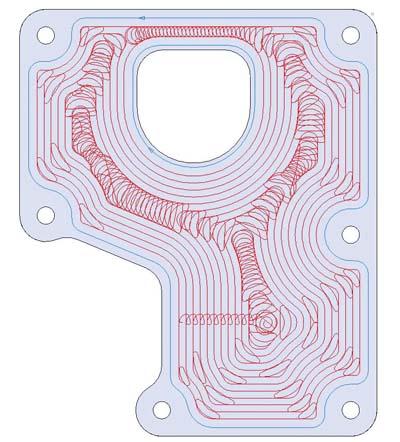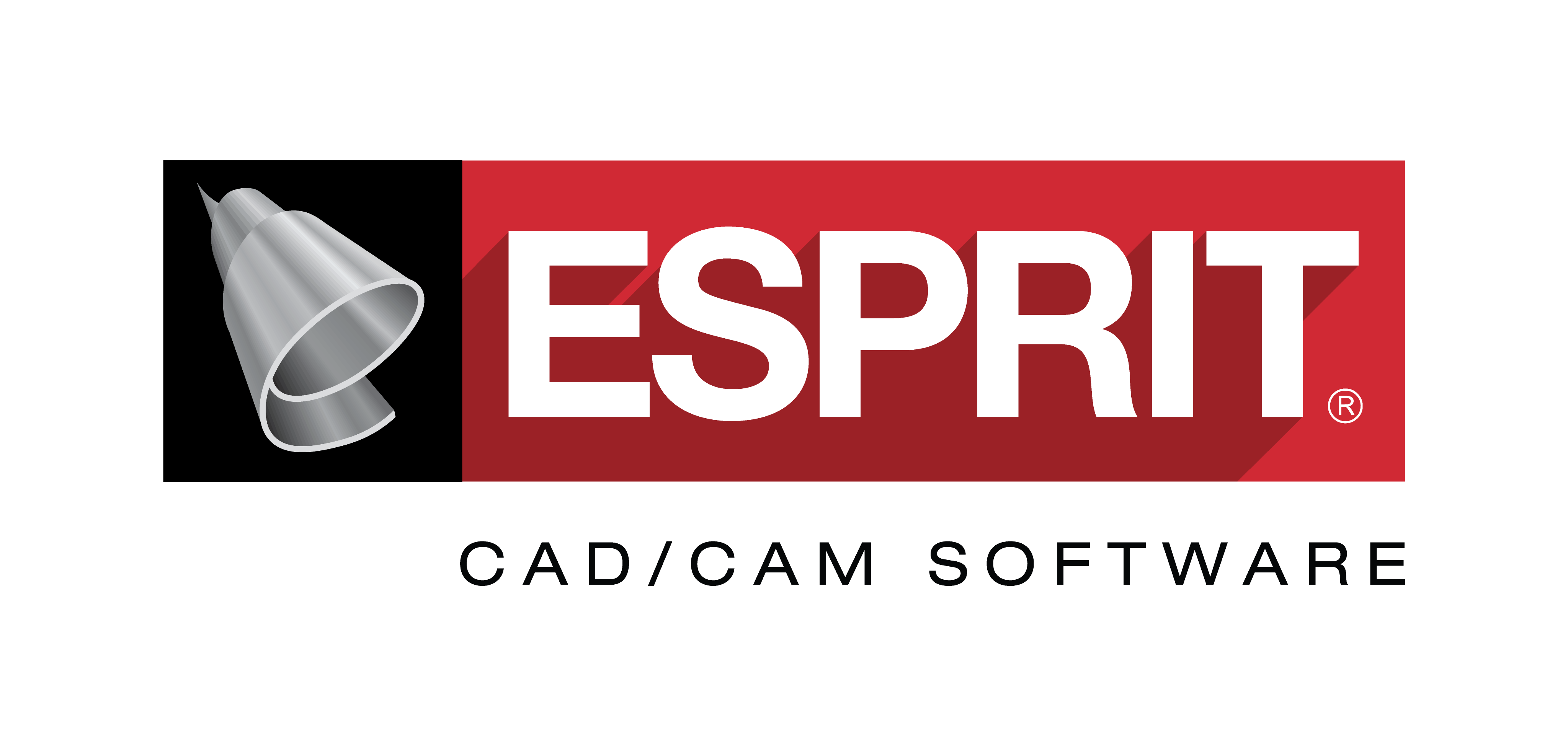
Computer-aided manufacturing (CAM) software developer DP Technology Corp. is shipping ESPRIT 2013, the latest version of its flagship software, designed to program today's multi-spindle, multi-turret mill-turn and Swiss-turn machine tools.
ESPRIT 2013 includes new productivity-enhancing technology for all CNC programmers and for all machining disciplines. This latest version focuses on providing new and enhanced machining technology that ensures smarter, more efficient toolpath and new strategies for greater overall productivity.
Featuring functionality that emphasizes higher cutting speeds, longer tool life and suitability to increasingly complex geometry, ESPRIT 2013 is reportedly comprehensive in its ability to handle today's most advanced machine tools and demanding machining applications.
Experience better CAM programming with ProfitMilling, a smart and efficient toolpath that puts greater profit in your pocket. New to ESPRIT 2013, the patent-pending ProfitMilling strategy for 2-, 3- and 5-axis roughing cycles allows customers to remove more material in a shorter period of time. Using highly advanced technology, the ProfitMilling strategy optimizes engagement angle, chip load, material removal rate (MRR), lateral cutter force and machine acceleration to achieve optimal results.
This innovative machining cycle represents the "best of both worlds" by utilizing trochoidal tool motion and a traditional offset of the toolpath, allowing usage of the full tool flute length.
"Our tests have shown that ProfitMilling typically reduces cycle time by 70 percent, minimizes programming time, reduces energy consumption, and increases tool life by an average of 500 percent," said ESPRIT Product Manager Kenyon Whetsell. "We've seen the most dramatic benefits in using the ProfitMilling strategies with light to medium-duty machine tools."
Trochoidal tool motion pattern has been improved in ESPRIT 2013 to take you even faster through your cuts. Improvements include an optimized trochoidal strategy to reduce cycle time and additional tool lifts during transitional moves to reduce tool drag.
ESPRIT 2013 offers new options for cutting grooves faster and more efficiently by taking advantage of the latest technology in grooving inserts. Among these upgrades is a new plunge setting added to the plunge turning (zigzag) cycle. Using a pre-plunge along walls reduces the tool load against walls and cuts wide grooves faster.
Also added is a lateral feed-rate setting that provides customers with more control and an option to perform extra-plunge along a profile to deliver fewer scallops for the finish pass. Also new in ESPRIT 2013 are two new strategies for the "Diagonal Zigzag" groove type: "Thin-to-Thick Chip" for a progressive engagement of the tool and "Thick-to-Thin Chip" that is particularly suited to ceramic inserts. It generates rapid metal removal without vibration, as well as improved finish and prolonged tool life.
ESPRIT 2013 offers a completely new editable and customizable engraving machining cycle that allows customers to use "True Type" fonts, single-stroke fonts or features of the part geometry. In addition to more conventional contouring and pocketing machining strategies, the ESPRIT 2013 engraving cycle introduces an available V- carving strategy. V-carving is dedicated to the usage of engraving tools with tapered ends. This strategy, specific for use with tapered engraving tools, offers benefits that include more accurate and aesthetic designs, the ability to machine sharp corners, and reduced cycle time.
Numerous enhancements and additions have been made to 3- and 5-axis FreeForm cycles in ESPRIT 2013.
A new 5-Axis Roughing Cycle has been designed to quickly and easily rough a 5-axis part using the same familiar technology used to rough a 3-axis part, including the new ProfitMilling pattern. The 5-Axis roughing cycle automatically adjusts the orientation of any tool shape (end mill, ball mill, bull-nose mill) to keep the tool perpendicular to the underlying surface, thereby eliminating undercuts.
Also new to ESPRIT 2013 is a 5-Axis Port Machining Cycle dedicated to machining cylindrical apertures and devised to cut as deeply as possible into a port while containing tool swings. This cycle is aided by an automatic recalculation of tool points along a spine curve.
ESPRIT 2013 features improvements for all 5-axis cycles, including the new, patent-pending 5-axis channel-roughing cycle. By directly selecting channel walls without creating complicated features, machining channels between thin blades is faster and easier than ever before; simply select the walls on either side of the channel, set the incremental depth and go. Another important enhancement is the ability to generate multi-level cuts by input of an incremental depth of cut.
Improvements to the 5-Axis Blade Machining Cycle include the ability to optimally machine a single blade from one end to the other. A new hub-blending option eliminates unwanted interruptions in the cut that occur when the tool reaches the end of the blade and comes into contact with the hub surface.
Additionally, the Impeller Machining Cycle now includes built-in remachining, which allows for the complete machining of an impeller without concern for tool dimensions. The impeller cycle allows customers to machine as far as possible using the current tool before automatically stopping at the first unreachable level. The system retains the maximum depth increment machined, which is then used to start the next roughing remachining. This flexible method allows multiple remachinings with decreasing tool sizes. The impeller cycle offers additional control over the tool orientation to avoid undesired table swing.
In ESPRIT 2013, new collision-detection strategies have been added to all 3-axis and 5-axis milling operations, which detect collisions while toolpath is being calculated instead of during the simulation process. ESPRIT can be instructed to recommend the minimal tool length to avoid collision, or to automatically trim away the colliding toolpath and reconnect with appropriate links.
The machining of engine ports and turbine blades requires precise control of tool motion, and ESPRIT 2013 makes the task easier than ever before with new curves and surfaces to guide the tool.
A major enhancement unique to ESPRIT 2013 is a new "Mid Surface" function added to the Knitted Surfaces toolbar. The new "Mid Surface" function is perfect for blade machining, where it serves two purposes: allowing for the calculation of toolpath from a single source instead of multiple faces on the model, and controlling the orientation of the tool axis throughout the cut, rather than on individual surfaces of the blade.
The new "Spine Curve" option creates a curve along the centers of radial surfaces and is ideal for port machining, as it allows programmers to guide the tool as far as possible into the opening.
The "Curve From Surface" command has been enhanced in ESPRIT 2013 with a new option to create either a parametric curve or a spine curve.
"Wrap Pocketing" and "Wrap Contouring," enhanced for ESPRIT 2013, now support the machining of non-cylindrical parts. In addition to wrapping a feature on a working diameter, a 3D feature chain may also be selected as an input, no longer necessitating "unwrapping" the feature. A distinct advantage over the legacy cycles, current wrap operations also offer the user the ability to apply a Y-axis offset in order to obtain the desired wall geometry.
Contact Details
Related Glossary Terms
- centers
centers
Cone-shaped pins that support a workpiece by one or two ends during machining. The centers fit into holes drilled in the workpiece ends. Centers that turn with the workpiece are called “live” centers; those that do not are called “dead” centers.
- computer numerical control ( CNC)
computer numerical control ( CNC)
Microprocessor-based controller dedicated to a machine tool that permits the creation or modification of parts. Programmed numerical control activates the machine’s servos and spindle drives and controls the various machining operations. See DNC, direct numerical control; NC, numerical control.
- computer-aided manufacturing ( CAM)
computer-aided manufacturing ( CAM)
Use of computers to control machining and manufacturing processes.
- computer-aided manufacturing ( CAM)2
computer-aided manufacturing ( CAM)
Use of computers to control machining and manufacturing processes.
- depth of cut
depth of cut
Distance between the bottom of the cut and the uncut surface of the workpiece, measured in a direction at right angles to the machined surface of the workpiece.
- gang cutting ( milling)
gang cutting ( milling)
Machining with several cutters mounted on a single arbor, generally for simultaneous cutting.
- grooving
grooving
Machining grooves and shallow channels. Example: grooving ball-bearing raceways. Typically performed by tools that are capable of light cuts at high feed rates. Imparts high-quality finish.
- milling
milling
Machining operation in which metal or other material is removed by applying power to a rotating cutter. In vertical milling, the cutting tool is mounted vertically on the spindle. In horizontal milling, the cutting tool is mounted horizontally, either directly on the spindle or on an arbor. Horizontal milling is further broken down into conventional milling, where the cutter rotates opposite the direction of feed, or “up” into the workpiece; and climb milling, where the cutter rotates in the direction of feed, or “down” into the workpiece. Milling operations include plane or surface milling, endmilling, facemilling, angle milling, form milling and profiling.
- milling machine ( mill)
milling machine ( mill)
Runs endmills and arbor-mounted milling cutters. Features include a head with a spindle that drives the cutters; a column, knee and table that provide motion in the three Cartesian axes; and a base that supports the components and houses the cutting-fluid pump and reservoir. The work is mounted on the table and fed into the rotating cutter or endmill to accomplish the milling steps; vertical milling machines also feed endmills into the work by means of a spindle-mounted quill. Models range from small manual machines to big bed-type and duplex mills. All take one of three basic forms: vertical, horizontal or convertible horizontal/vertical. Vertical machines may be knee-type (the table is mounted on a knee that can be elevated) or bed-type (the table is securely supported and only moves horizontally). In general, horizontal machines are bigger and more powerful, while vertical machines are lighter but more versatile and easier to set up and operate.
- plunge turning
plunge turning
Form of hard turning that uses the entire cutting edge or a portion of the cutting edge to create an orthogonal cut.
- toolpath( cutter path)
toolpath( cutter path)
2-D or 3-D path generated by program code or a CAM system and followed by tool when machining a part.
- turning
turning
Workpiece is held in a chuck, mounted on a face plate or secured between centers and rotated while a cutting tool, normally a single-point tool, is fed into it along its periphery or across its end or face. Takes the form of straight turning (cutting along the periphery of the workpiece); taper turning (creating a taper); step turning (turning different-size diameters on the same work); chamfering (beveling an edge or shoulder); facing (cutting on an end); turning threads (usually external but can be internal); roughing (high-volume metal removal); and finishing (final light cuts). Performed on lathes, turning centers, chucking machines, automatic screw machines and similar machines.

